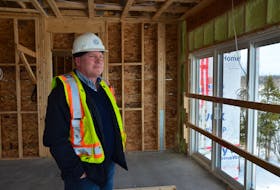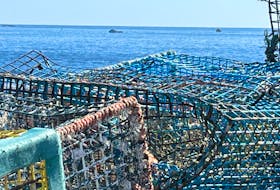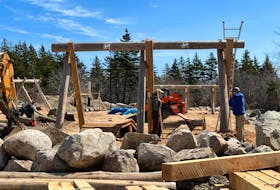AMHERST, N.S. – Amherst’s new fire simulator is so life-like, it’s already led one citizen to believe there was an actual fire.
“We’d just received the panel and had it on the floor simulating different types of fires,” Fire Chief Greg Jones recalled recently. “Someone driving by thought it was a real fire. He actually came into the station to report it.
“We showed him the simulator. He was impressed because from the street, he said it looked very real.”
During a recent Thursday night training session, several firefighters echoed the man’s comments, saying the simulated fire they doused was the closest they’d come in training to the real thing.
Known as a Bullex Attack System, the approximately $40,000 simulator contains an electronic nozzle, a weighted fire hose that simulates a fire hose full of water, a digital simulation panel that simulates flames, and a smoke generator. The panel can be used in wet or dry conditions.
All of these components are linked through a Wi-Fi network to a portable control panel that lets the operator determine the amount of smoke being generated and the intensity of the flames.
“The system lets us train as close to the real thing as possible in a safe environment,” Jones said, noting the smoke generated by the system is non-toxic.
On this training night, firefighters were facing a simulated structure fire that was set up in a garage located at the back of the fire hall. Wisps of smoke could be seen leaking out around door and window frames as firefighters approached. Through the windows, you could see a flickering, yellow light.
Working in pairs, firefighters, wearing full protective gear and breathing apparatus, were met with a wall of smoke when they entered the “burning structure” via a “window.”
Like a real fire, visibility was better close to the ground. Through the haze, they could see and hear the flickering flames. Hauling the hose over, under and around obstacles, they approached the flames.
When they got within range, they used the nozzle in the normal manner, but instead of water jetting out, a circular beam of light poured onto the simulated fire. Using the same techniques as they would with a regular hose, they extinguished the blaze.
On some occasions, Chris Clark, the man handling the remote control, would increase the amount of smoke, other times he increased the amount of flames, sometimes he increased both, and other times, he would make it appear the fire was knocked down, only to have it flare up.
“That’s what is great about the system,” Jones said. “We can simulate what happens in a real fire. So just like a real fire, where it could appear to be extinguished, we can make it reignite, and the firefighters have to use their training react to it in the proper way.”
While each pair was going through the drill, they were monitored by another firefighter holding a hand-held thermal imaging camera.
Some of the firefighters were wearing new breathing apparatus recently obtained by the town that contains a major advancement – a thermal-imaging camera built right into the apparatus’s control panel. It enabled them to see through the smoke, without having to use the large hand-held camera.
The fire simulated during the training session was known as a Type A fire, which means basic combustible materials, like wood, was “on fire.”
There are three other classifications of fires. Type B is liquid fire, like gas or oil burning. Type C is an electrical fire, like those found in burning electrical panels and Type D is a combustible metal fire like magnesium.
“What’s great about the simulator is we can simulate all the different types of fires, which means during our training sessions we can have our folks experience what those fires are like and practise the different techniques used to put them out without the danger inherent in a real fire,” the chief said.
Another advantage is the simulator is portable.
“We can set it up almost anywhere. In a classroom, in the fire hall, our garage or some other location,” Jones said. “So, if the public sees us training in a location where there is a lot of smoke, they shouldn’t get too worried.”








